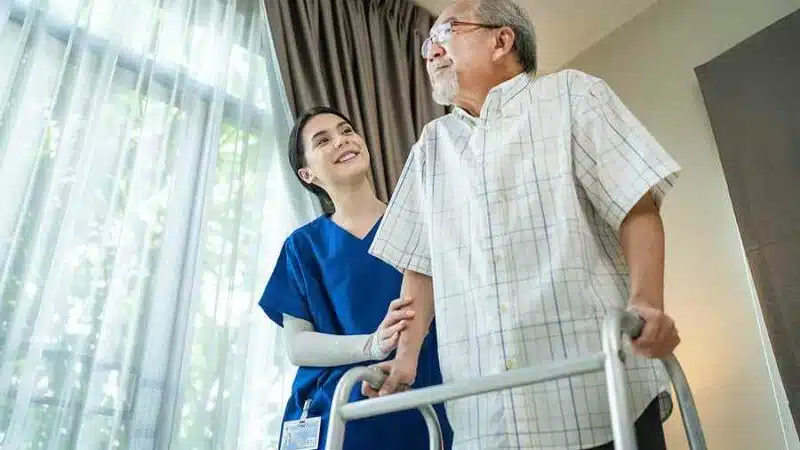Can A Vitamin Stop Age-Related Muscle Loss

The loss of muscle as we age, is becoming an increasing problem.
If you’re in your 50s or older, you have likely noticed a slow loss of muscle strength. Essentially that is the ageing process at work.
The loss of muscle strength as we age is also known as sarcopenia. Our skeletal muscle mass is slowly diminishing as we age. So many of us want to know what we can do about this.
As we reach our 60s we are generally at greater risk of many chronic diseases, which will lower our health-related quality of life.
Can A Vitamin Stop Age-Related Muscle Loss?
Sadly the short answer is no. There is no one vitamin that can achieve this. There are no pharmaceuticals available that can ‘treat’ sarcopenia. So there are no magic bullets in that respect.
If only it were so easy that we could pop a pill and start to regain the muscle of our youth!
But like most things in life, it involves taking preventative action and that can involve the use of nutrients to assist.
Combined with resistance training, this two-pronged attack can help to increase muscle mass and strength as we age.
Nutrients That Fight Sarcopenia
Evidence does show that older people may benefit from a greater intake of nutrient-rich sources of protein.
It’s hypothesized that this age group need more protein than the recommended daily allowance of 0.8 grams per day, if they are to retain their strength and muscle mass.
Certain nutrients can help combat sarcopenia and slow down the loss of muscle mass.
Protein, particularly high-quality protein such as lean meats, fish, eggs, and dairy products, is essential for building and repairing muscles.
Vitamin D supplementation works in conjunction with calcium, to support bone health which is important for maintaining muscle strength.
Omega-3 fatty acids have anti-inflammatory properties that may prevent or slow down the rate of age-related muscle loss as well.
Creatine supplementation has been shown to increase strength and lean body mass in older adults, who engage in resistance training programs.
What Age Does Muscle Mass Loss Begin In Older Adults
Age-related muscle loss or sarcopenia typically starts around the age of 50, sometimes a little earlier and can accelerate after the age of 60.
You will probably notice if you have reached your 50s, a loss in your own muscle mass. Even if you’re exercising regularly, you will notice difficulty in maintaining the muscle mass of your youth.
Of course, you don’t lose your muscle strength overnight; it’s a rather insidious process.
The onset of sarcopenia is gradual, and it often takes years for the symptoms to manifest. As you age, there is a natural decline in muscle mass due to hormonal changes, inflammatory processes, and physical inactivity.
This will inevitably lead to a loss of muscle tissue and overall healthy muscle mass.

What Causes A Loss Of Muscle Mass as We Age
The medical name for muscle loss caused by ageing is sarcopenia.
It’s not known exactly when sarcopenia begins, but it’s measurable in most people around 50 years old – when muscle mass decreases at an average of 0.5 to 1% per year and strength at between 1 and 3% per year.
Causes Of Sarcopenia
The condition is age-related, but is hastened by a lack of physical activity and low dietary energy. – especially protein intake.
Sarcopenia is associated with an increased risk of falls and fractures and the development of frailty.
Building muscle can also prevent other diseases
What you may not realise is that the loss of muscle mass and function can also be involved in metabolic diseases, like type 2 diabetes and indeed, cardiovascular disease.
When we lose muscle mass, we decrease our ability to perform a whole range of everyday functions.
When left unaddressed, sarcopenia can lead to disability and can exacerbate other chronic diseases.
How Can I Go About Preventing Sarcopenia
Well, the good news is that sarcopenia, and age-related skeletal muscle loss, can indeed be reversed, to a degree.
Although supplementation with vitamins, isn’t really going to make as much of an impact as resistance training
Chronic disease in later life, combined with loss of strength and muscle mass, often lead to a loss of physical mobility, which puts older persons at risk for further health problems or worsening existing chronic diseases, all of which are precursors to the development of frailty.
Maintaining muscle mass through exercise
Exercise is a potent strategy for combatting muscle loss in older people. It provides both mechanical and metabolic stimulation to the muscles that help maintain strength, mass, endurance, and power.
Resistance or strength training involves working out with weights or resistance machines that stimulate the growth and repair of muscles by applying tension. This can be very effective in slowing the rate of muscle loss in older adults.
It is widely recognised that exercise can reverse sarcopenia to a great degree
Regular aerobic exercise such as walking, cycling, swimming also promotes cardiovascular health while engaging major muscle groups throughout the body which can prevent sarcopenia.
Exercise has been shown to improve quality of life in older adults by reducing the risk of falls, fractures and improving mobility
Periodic inactivity is also an important factor in unsuccessful aging.
Factors such as poor mental and physical health and social isolation can easily lead to greater inactivity.
Older people tend to go outdoors less in bad weather conditions, and if they contract something like the flu, they can suddenly find themselves hospitalized and convalescing for longer periods.
During this period of inactivity, there is often a loss of strength and muscle mass, which is much more difficult to recover in older persons.
Remain active to avoid loss and diminished muscle mass
Even more importantly, studies show that if an older person remains physically active, they have a lower risk of chronic disease and a higher chance of aging successfully.
Healthcare professionals, policymakers, and communities should work together to develop and implement programs that encourage older adults to engage in regular physical activity, consume adequate protein, and maintain social connections.
This could include offering accessible exercise facilities, organizing group activities, and providing educational resources on proper nutrition and exercise for older adults.
Moreover, families and caregivers play a crucial role in supporting and encouraging their aging loved ones to make these healthy lifestyle choices. Open communication about the challenges and barriers faced by older adults is essential in finding the most effective solutions.
In conclusion, the key to successful aging and reducing the impact of sarcopenia is a combination of physical activity, proper nutrition, and social engagement.
By addressing these factors proactively, we can help ensure a better quality of life for older individuals and enable them to maintain their independence and well-being for as long as possible.





